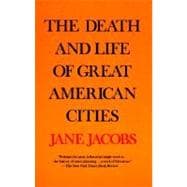
Note: Supplemental materials are not guaranteed with Rental or Used book purchases.
Purchase Benefits
Looking to rent a book? Rent The Death and Life of Great American Cities [ISBN: 9780679741954] for the semester, quarter, and short term or search our site for other textbooks by JACOBS, JANE. Renting a textbook can save you up to 90% from the cost of buying.
| Introduction | p. 3 |
| The Peculiar Nature of Cities | |
| The uses of sidewalks: safety | p. 29 |
| The uses of sidewalks: contact | p. 55 |
| The uses of sidewalks: assimilating children | p. 74 |
| The uses of neighborhood parks | p. 89 |
| The uses of city neighborhoods | p. 112 |
| The Conditions for City Diversity | |
| The generators of diversity | p. 143 |
| The need for primary mixed uses | p. 152 |
| The need for small blocks | p. 178 |
| The need for aged buildings | p. 187 |
| The need for concentration | p. 200 |
| Some myths about diversity | p. 222 |
| Forces of Decline and Regeneration | |
| The self-destruction of diversity | p. 241 |
| The curse of border vacuums | p. 257 |
| Unslumming and slumming | p. 270 |
| Gradual money and cataclysmic money | p. 291 |
| Different Tactics | |
| Subsidizing dwellings | p. 321 |
| Erosion of cities or attrition of automobiles | p. 338 |
| Visual order: its limitations and possibilities | p. 372 |
| Salvaging projects | p. 392 |
| Governing and planning districts | p. 405 |
| The kind of problem a city is | p. 428 |
| Index | p. 449 |
| Table of Contents provided by Blackwell. All Rights Reserved. |
The New copy of this book will include any supplemental materials advertised. Please check the title of the book to determine if it should include any access cards, study guides, lab manuals, CDs, etc.
The Used, Rental and eBook copies of this book are not guaranteed to include any supplemental materials. Typically, only the book itself is included. This is true even if the title states it includes any access cards, study guides, lab manuals, CDs, etc.
Excerpted from The Death and Life of Great American Cities by Jane Jacobs
All rights reserved by the original copyright owners. Excerpts are provided for display purposes only and may not be reproduced, reprinted or distributed without the written permission of the publisher.